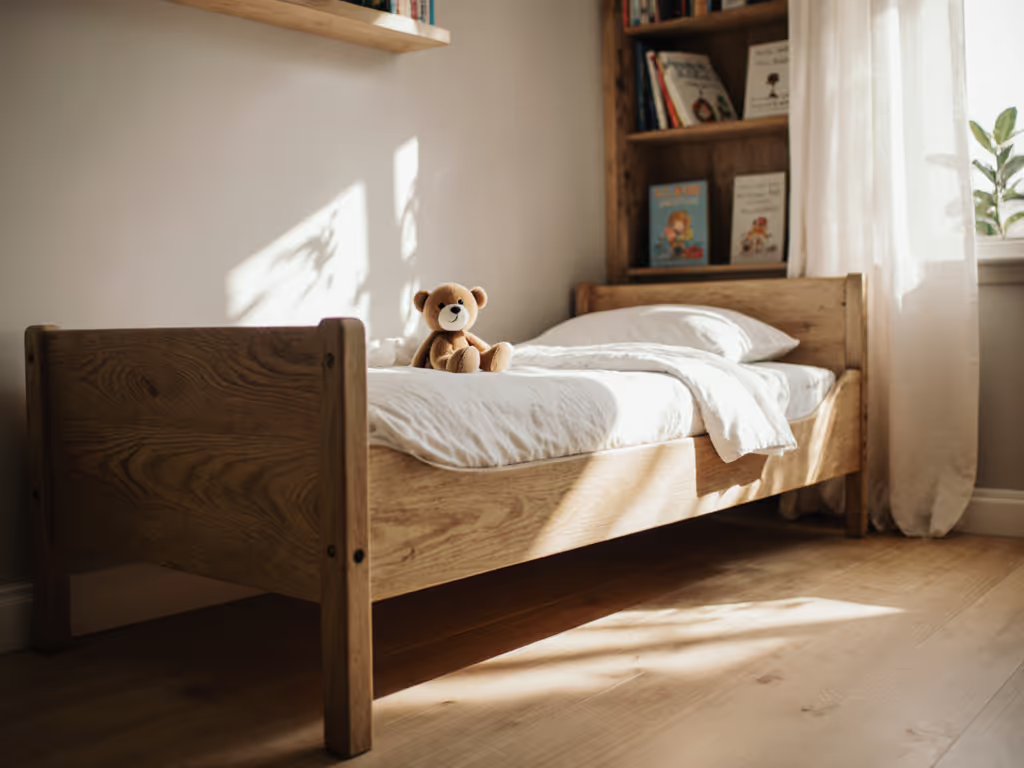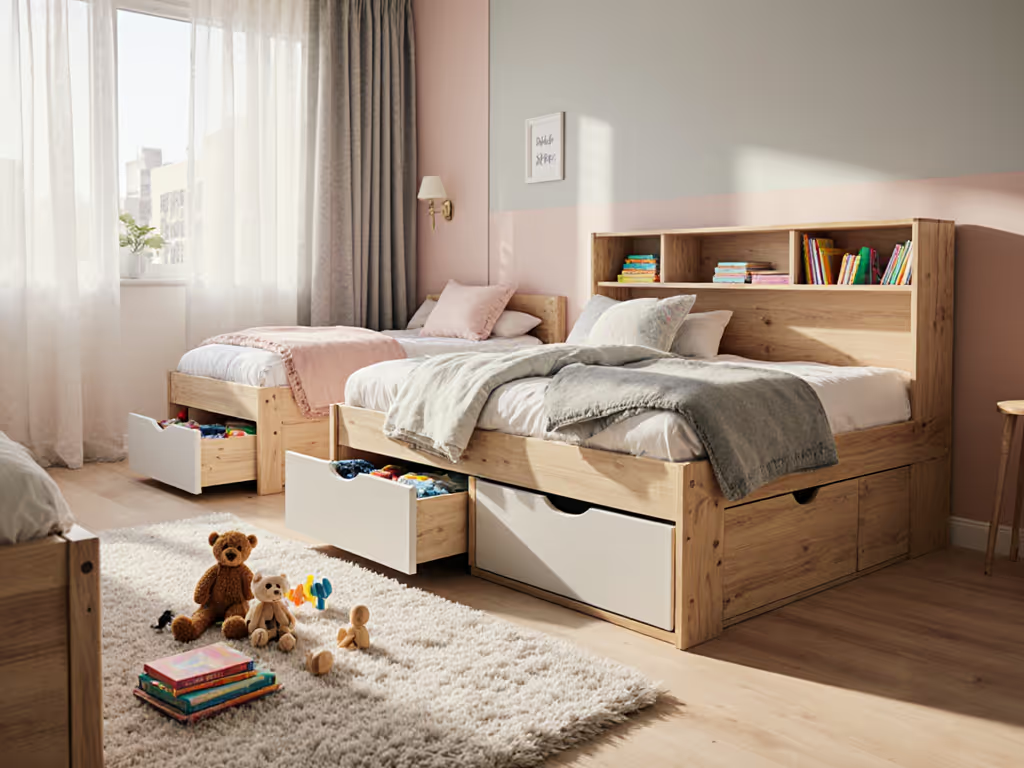
Toddler Bed Selection Guide for Safe, Space-Saving Choices

Over 70 percent of children sleep longer when they have a dedicated, well-arranged space for rest. Choosing the right toddler bed is more than a simple furniture pick. It shapes your child’s quality of sleep and nighttime routines while easing your life as a parent. With expert-backed tips on sizing, safety, longevity, and smart placement, this guide helps you make confident choices for your growing family.
Quick Summary
| Key Point | Explanation |
|---|---|
| 1. Measure your space accurately | Assess room dimensions and layout to ensure the toddler bed fits comfortably and fosters a good sleeping environment. |
| 2. Prioritize safety features | Choose beds with sturdy construction and guardrails that meet U.S. safety standards to protect your child. |
| 3. Consider convertible bed options | Look for beds that can grow with your child, transforming from toddler beds to larger sizes over time. |
| 4. Evaluate durability for long-term use | Invest in high-quality materials to ensure the bed withstands toddler activities and lasts for years. |
| 5. Verify fit and placement | Confirm the bed's dimensions align with your room measurements, allowing for safe movement and accessibility. |
Step 1: Assess Your Space and Sleeping Needs
Selecting the perfect toddler bed starts with understanding your unique living environment and your child's specific sleeping requirements. Think of this as a strategic puzzle where room dimensions, layout, and your little one's comfort intersect to create the ideal sleep solution.
Start by measuring your available bedroom space precisely. Pull out a tape measure and note the total square footage, wall lengths, and potential bed placement areas. A small apartment might require a more compact bed design compared to a spacious bedroom. According to research from the Sleep Foundation, children with dedicated sleeping spaces can gain up to 28 minutes of additional sleep per night—which makes your spatial assessment critically important.
Consider your toddler's specific needs alongside room constraints. Will the bed be placed against a wall? Near a window? Next to a sibling's bed? Some toddler beds offer convertible designs that adapt as your child grows, maximizing your investment. The Sleep Charity recommends creating a neutral environment with consistent room temperature around 18 degrees Celsius to promote optimal sleep conditions. Pay attention to potential distractions like electronics or busy street views that might interrupt your child's rest.
Pro tip: Always leave some wiggle room around the bed for movement and future furniture adjustments. Cramped spaces can create stress for both parents and children during bedtime routines.
Step 2: Set Safety and Eco-Friendly Criteria
Now that you understand your space requirements, it is time to dive into the critical world of toddler bed safety and environmental considerations. Your goal is to select a bed that protects your child while also supporting a healthy living environment.
Start by reviewing the mandatory safety standards outlined by the U.S. Consumer Product Safety Commission. Their guidelines are comprehensive and designed to prevent serious risks like entrapment and strangulation. Look for beds that feature sturdy guardrails with minimal gaps, solid construction, and clear labeling indicating compliance with current safety regulations. Experts recommend choosing beds made from solid hardwoods like maple or birch which provide superior structural integrity and minimize potential chemical exposure.
When evaluating eco-friendly options, pay close attention to the bed's materials and finishes. According to research from Craft-Child, water-based non-toxic paints and sustainably sourced wood can significantly reduce your child's exposure to harmful chemicals. Solid hardwood beds not only offer durability but also tend to off-gas fewer volatile organic compounds compared to engineered wood products. Consider beds with certifications from recognized environmental organizations as an additional layer of confidence in your selection.
Pro tip: Always inspect the bed in person when possible. Run your hands along the edges, check for smooth surfaces without splinters, and verify that all connections are tight and secure. Your hands and eyes can catch potential safety issues that product descriptions might miss.

Step 3: Compare Toddler Bed Types and Features
With safety and space considerations in mind, you are now ready to explore the diverse world of toddler bed types and their unique features. This step is about finding the perfect match that balances comfort, practicality, and your child's growing needs.
According to research from Carbrini Furniture, toddler beds come in three primary materials: wood, plastic, and metal. Each material offers distinct advantages. Wooden beds crafted from solid pine or hardwoods provide exceptional durability and a classic aesthetic. Plastic beds are lightweight and often more affordable, while metal frames can offer sleek modern designs with robust structural support. Pay attention to specific construction details like guardrail placement, mattress support, and overall frame stability. Snuglee's safety research emphasizes the importance of free knot solid pine beds that minimize potential structural weak points and reduce entrapment risks.
When comparing bed types, consider convertible options that can adapt as your child grows. Some models transition from toddler beds to junior beds or even full sized beds, providing long term value. Look for features like removable side rails, adjustable mattress heights, and rounded edges that enhance both safety and functionality.
Consider your child's individual sleeping habits memory foam might work better for restless sleepers while traditional spring mattresses could suit more stationary children.
Pro tip: Bring your child along when possible to test beds. Their comfort and reaction can be the ultimate deciding factor in selecting the right toddler bed.
Step 4: Evaluate Durability and Long-Term Value
As you narrow down your toddler bed choices, understanding durability and long term value becomes crucial. This step is about making a smart investment that grows with your child and withstands the inevitable bumps, jumps, and creative play that come with toddlerhood.
Consider the bed's construction quality as a key indicator of potential longevity. Look for solid wood frames with reinforced joints and high quality hardware that can handle daily wear and tear. Pay attention to the finishing details such as smooth edges, robust attachment mechanisms, and materials that resist scratching or chipping. Convertible beds offer exceptional value by adapting to your child's changing needs transforming from a toddler bed to a junior bed or even a full sized bed as your little one grows.
Think beyond the immediate purchase and calculate the bed's potential lifespan. A slightly more expensive bed with superior craftsmanship might save you money in the long run by eliminating the need for frequent replacements. Consider factors like warranty coverage, the manufacturer's reputation for quality, and user reviews that highlight real world durability. Look for beds with modular design features that allow for easy repair or part replacement rather than requiring a complete bed replacement if a single component becomes damaged.
Pro tip: Test the bed's sturdiness by gently applying pressure to different points. A quality toddler bed should feel stable and resilient without excessive wobbling or creaking sounds.
Step 5: Verify Fit and Installation in Your Room
With your ideal toddler bed selected, the next crucial step is ensuring it integrates seamlessly into your child's bedroom. This process requires careful measurement, strategic placement, and thoughtful consideration of room dynamics.
Begin by revisiting your room measurements and comparing them precisely with the bed's dimensions. Pay close attention to not just the bed's footprint, but also potential clearance needed for movement and other furniture. Research from Laois Childcare highlights the importance of spacing recommendations that suggest maintaining at least 50 centimeters between sleeping areas. This guidance ensures not only safety but also allows for easy maneuverability and potential future room reconfigurations. Consider potential obstacles like heating vents, windows, or electrical outlets that might impact bed placement.
Think strategically about the bed's orientation and proximity to other bedroom elements. Position the bed away from direct drafts, heating sources, or potential hazards like unsecured furniture or dangling cords. If you have multiple children sharing a room, consider how the new bed will interact with existing sleeping arrangements. Test the installation by doing a walkthrough simulation check. Move around the room as if carrying a child, ensuring there are no awkward angles or potential bumping points. Check that guardrails align correctly, mattress fits snugly, and the overall setup feels intuitive and comfortable.

Pro tip: Take photos of your planned bed placement and show them to a friend or family member. Fresh eyes can often spot potential issues you might have overlooked.
Find the Perfect Toddler Bed That Fits Your Space and Keeps Your Child Safe
Selecting the right toddler bed can feel overwhelming with space limits, safety concerns, and your child’s comfort all on the line. This guide highlights the real challenges parents face like measuring room size accurately, finding beds that meet strict safety standards, and choosing durable options that grow with your toddler. You want a bed that not only fits your room well but also gives you peace of mind knowing your child will sleep soundly and safely.
At City Toddler Beds, we understand these concerns deeply. Our resources break down important factors such as eco-friendly materials, guardrail safety, and convertible designs to help you avoid common pitfalls. Don’t wait until bedtime battles start to rethink your choices. Explore our comprehensive guides and expert advice today to make confident decisions for your child’s sleep space. Visit https://citytoddlerbeds.store now to start creating a safe, space-saving bedroom your family will love.
Frequently Asked Questions
How do I assess my space for a toddler bed?
Start by measuring the available bedroom space, including wall lengths and potential bed placements. Ensure that you leave some wiggle room around the bed for future furniture adjustments and movement.
What safety features should I look for in a toddler bed?
Prioritize beds that meet mandatory safety standards, such as sturdy guardrails and solid construction. Ensure the bed has no gaps that could pose entrapment risks and feel the edges to confirm there are no splinters or rough areas.
Are there eco-friendly options for toddler beds?
Yes, look for beds made from solid hardwood and finished with non-toxic paints. Opt for beds that have certifications indicating they are free from harmful chemicals to promote a healthy sleeping environment.
What types of toddler beds are available and their benefits?
Toddler beds mainly come in wood, plastic, and metal. Wooden beds provide durability and a classic look, while plastic beds are lightweight and often more affordable; metal frames offer modern designs with strong structural support.
How can I evaluate the durability of a toddler bed?
Inspect the bed’s construction quality, focusing on solid wood frames and reinforced joints. Test its sturdiness by applying gentle pressure to different points to ensure it feels stable and resilient against daily wear and tear.
What steps should I take to ensure proper fit and installation of the toddler bed?
Recheck the room measurements against the bed’s dimensions and maintain at least 50 centimeters of space around sleeping areas. Ensure the bed is placed away from heating sources and direct drafts, and simulate movement in the room to check for functionality.




